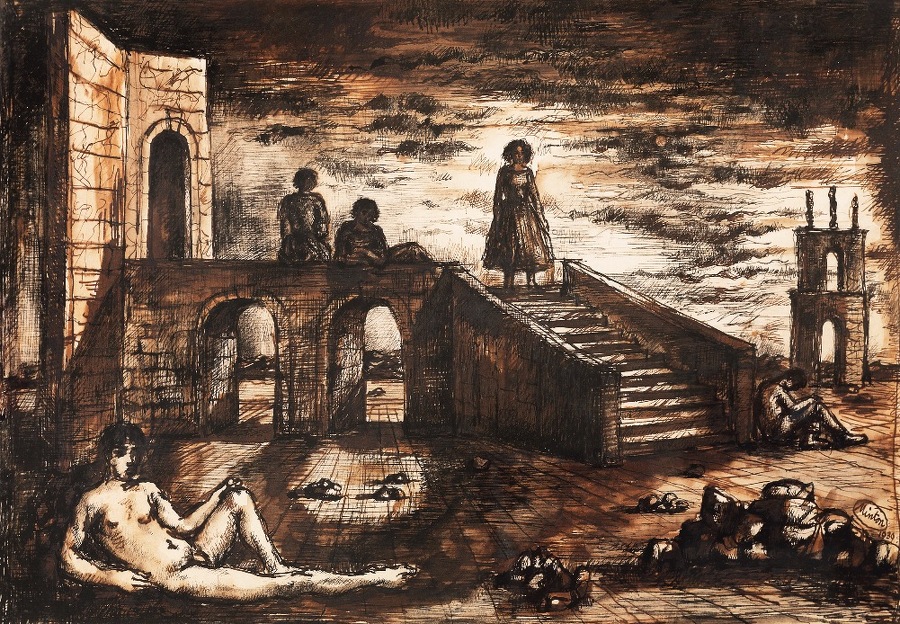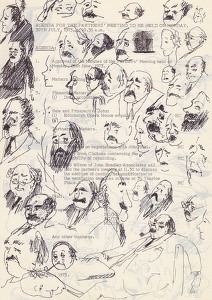

1917-1957
The Desolate Stage
Ref: 1568
Signed and dated l.r.: Minton 1939
Pen, ink and wash, 30 by 47 cm
Provenance: with Abbott & Holder Ltd
Exhibited: John Minton – A Centenary, Pallant House Gallery, Chichester, July 1 – October 1 2017, cat., Fig. 7 page 15, illustrated in colour
As art students John Minton, Michael Ayrton and Michael Middleton formed an alliance, going regularly to the ballet together. All three read James Thrall Soby’s After Picasso which had been published in America in 1935. In the book Soby promoted two contemporary movements, Neo-Romanticism and Surrealism.
The Neo-Romantics who interested Minton, Ayrton and Middleton were the Paris-based Russians, Eugene Berman and Pavel Tchelitchew, and the Frenchman, Christian Berard who was more famous as a stage designer than as a painter. Berman was the one who influenced Minton most, had made frequent visits to Italy, especially to Venice, where he found architectural settings which he incorporated into imaginative and nostalgic images, made additionally moody by the dominant use of blue. Soby’s book made urgent Minton’s departure for Paris where he was to have first-hand experience of the artists he here read about. He left England at the very end of December 1938, having come of age on Christmas Day, and after a winter sports holiday at Villars, in Switzerland, he was Paris-based on the Left bank from February 1939. (Michael Ayrton arrived in April). In his letters home he often concluded with a drawing in which he sometimes used the striking perspectives and stagy vistas employed by both the Neo-Romantics and the Surrealists. The figures he now drew had begun to take on a poignancy similar to that found in Picasso’s Blue Period.
Aware that Eugene Berman had painted at Les Baux, the ancient ruined town perched on a rocky outcrop in Provence, Minton and Ayrton determined to visit it. His experience of Les Baux allowed a number of influences in Minton’s art to coalesce. Here he found a terrain in which he could explore the ominous silence that the Italian surrealist George de Chirico had created. Likewise, Minton makes his vistas tense by strewing the foreground with shards of rock and sharply etched shadows. The unending space is often offset by a foreground figure in tattered clothes, either standing or asleep, whose wistful beauty is reminiscent of Berard’s paintings of back-street waifs. There is also something of Tchelitchew in the mood of otherworldliness, whilst Berman’s example may have inspired Minton’s choice, in his paintings, of tenebrous colouring.
In 1958, following Minton’s death in the previous year, Michael Middleton – who eventually became an art critic – remembered working alongside him in Paris: All through the last, long pre-war summer in France, he played with their (the Parisian neo-romantics’) emotive devices – the crepuscular tonalities, the deep perspectives and long shadows, the preoccupation with sleep and shrouded figures, the torn flags and cracked walls and ruined vistas that were so soon to look prophetic.
The present work is a fine example of Minton’s work from the period and was probably executed between February and August 1939. It has been known under a variety of titles including simply Design for a Stage Set (Sotheby’s sale, 3rd March 1999), acquiring the present title (by which it was described in the major Minton retrospective at Pallant House, Chichester in 2017) following its sale at Abbott & Holder in 1999.
The present text is closely based on material from Frances Spalding’s biography of John Minton, Dance till the Stars Come Down, published by Hodder & Stoughton in 1991.
 Private Collection
Private CollectionEnquire



